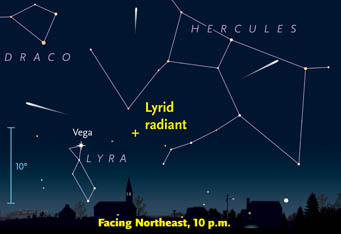The annual Lyrid meter shower is not typically dramatic, and this year strong moonlight will interfere. But skywatchers should be alert for a possible outburst on the night of April 21–22.
Late nights and mornings around April 22nd bring the annual, and highly variable, Lyrid meteor shower. Outbursts of Lyrids have been seen since at least 687 B.C. (when Chinese records say "stars dropped down like rain"), but in most years meteor watchers count 10 to 20 visible per hour under ideal conditions. At intervals of about 12 years the shower occasionally performs more than 10 times as well. But the 12-year cycle itself is very spotty.
Why does it happen at all? The orbital periods of the meteoroids and their source, Comet Thatcher (C/1861 G1), are much longer: about 400 years. Complex gravitational perturbations caused by Jupiter seem to be acting on separate, narrow strands within the overall Lyrid meteoroid stream. Each of these substreams was shed by Comet Thatcher during a past return to the inner solar system.

The Lyrid shower's radiant rises as early as 10 p.m., but you'll likely see more meteors once it climbs much higher in the sky before dawn.
Sky & Telescope diagram
According to this model the next Lyrid outburst won't come until 2040. But no one knows for sure what's going on, and if past outbursts were missed (they tend to last only about 6 hours) the model might be incorrect. So observers are needed to keep the Lyrids under watch.
This year the light of the nearly full Moon will interfere, but at least you can determine whether an outburst is in progress at the times you're looking. Watch late on the night of April 21st or before dawn's first light on April 22nd, when the shower's radiant (near Vega) is high in the sky. For mid-northern observers, there's a narrow window around 4 a.m. when the sky is still dark after the Moon has set in the west.
Find observing tips in Sky & Telescope's guide to observing meteors.
 2
2









Comments
Allen Fenderson
April 19, 2013 at 2:41 pm
Why does the Interactive Sky Chart not allow me to change the location perameter? I can change the date and time but the Location (I'd like to enter my location) when clicked on just responds with a "!" and an audible click. Same non-responsiveness when I click on "HELP".
You must be logged in to post a comment.
[email protected]
April 28, 2013 at 8:23 am
That's all I get from the Interactive sky chart. Why?
You must be logged in to post a comment.
You must be logged in to post a comment.